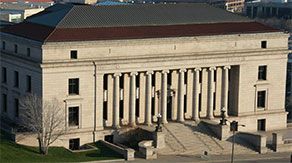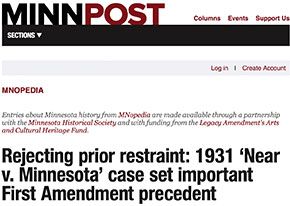Understanding The North Star State’s Dept. Of Public Safety
The Minnesota Criminal Justice System is composed of the Department of Public Safety (DPS), the Minnesota Judicial Branch (MJB) and the many law enforcement agencies that enforce the jurisdictions and policies of these two departments.
The MJB manages the laws of the state, sentencing, and procedure. The MJB is also responsible for licensing and services associated with public safety information, traffic safety, alcohol and gambling, fire safety, driver licensing and vehicle registration, and law enforcement.

The MJB consists of three levels of court. From the highest level, they are the Supreme Court, the Court of Appeals, and the District Courts. The Supreme Court handles high-level cases, but also has the responsibility for regulating the practice of law and the proclamation of statewide procedural rules and practices before all courts of the state. The Minnesota Supreme Court has seven justices, each of whom serve six-year terms after a statewide non-partisan ballot. If a justice dies, resigns, or otherwise leaves office, the governor appoints someone to finish the term. The judges must be lawyers, but they cannot practice law while in office.
The Minnesota Court of Appeals offers a prompt and deliberate review of all final rulings from trial courts, state agencies, and municipal governments. This court is known as an “error-correcting” court, and handles the majority of appeals in the state. This, in turn, allows the Minnesota Supreme Court to manage its caseload, and spend time resolving constitutional and public policy cases. Most appeals to the Supreme Court originate in the Court of Appeals after reviewing a decision from a lower court. The Court of Appeals has 19 judges and one chief justice who is appointed by the governor for a term of three years. The chief justice serves as the head of court. The other judges serve for terms of six years.
At the bottom of the court structure are the district - or trial - courts. They handle the majority of cases in the state, including cases that involve civil action, criminal decisions, family, juvenile, probate, and ordinance violation cases. Out of the 293 district court judges, one from each of Minnesota's 10 judicial is elected as a chief judge for a two-year term. They are responsible for managing the judicial district.
“ The MJB consists of three levels of court. From the highest level, they are the Supreme Court, the Court of Appeals, and the District Courts. ”
MINNESOTA JUDICIAL BRANCH STRUCTURED
Minnesota Supreme Court
Appeals from: Court of Appeals
Trial court decisions if Supreme Court chooses to bypass the Court of Appeals
Tax Court Appeals
Workers’ Compensation Court of Appeals
Original Actions: First-degree murder convictions
Writs of Prohibition
Writs of Habeas Corpus
Writs of Mandamus
Legislative election contests
Minnesota Court of Appeals
Appeals from: All trial court decisions, except first degree murder convictions
Decisions of Commissioner of Economic Security
Administrative agency decisions, except Tax Court & Workers’ Compensation Court
Original Actions: Writs of mandamus or prohibition, which order a trial judge or public official to perform a specified act, such as permitting media coverage of a hearing
Minnesota Trial (District) Courts
Original Actions: Civil Actions
Criminal Actions
Family
Juvenile
Probate
Violations of city ordinances
Appeals from: Conciliation Court
Conciliation Division: Civil disputes up to $10,000
Called trial de novo-actually a new trial, not just a review of the conciliation court.
Writ of prohibition-asks that a governmental body or official be prevented from doing something that might cause harm.
Habeas corpus-a complaint alleging that someone has been unlawfully confined and is asking for release.
Mandamus-asks that a governmental body or official be commanded to perform a specific act.
The Department of Public Safety represents 15 different divisions devoted to promoting public safety and awareness.
THE DPS
The DPS is responsible for determining the best way of detection, apprehension, and incarceration of criminal elements. It represents 15 different divisions devoted to promoting public safety and awareness through frequent updates on news and procedure. These include the divisions of the:
Alcohol and Gambling Enforcement
This division is largely responsible for regulating controlled substances like alcohol and activities that involved organized gambling and betting.
Bureau of Criminal Apprehension
This division provides investigative and specialized law enforcement services in an attempt to prevent and solve crime. They do this in partnership with law enforcement, public safety and criminal justice agencies, and more. Common services of this division include criminal justice training and development, forensic and laboratory analysis.
Commissioner’s Office
This division oversees department staff, programming and initiatives. They are the branch that administers most of the DPS’s agencies. They also coordinate the functions and services of the state relating to safety and convenience of its citizens as outlined in Minnesota Statute, Chapter 299A.
Driver and Vehicle Services
Serving over 11 million customers every year, the Driver and Vehicle Services division provides services related to vehicle ownership, driver education and evaluation, licenses, state identification cards, disability services, Motor carrier and freight registration and tax collection, dealer licensing, salvage and reconstructed vehicle inspections, collection of crash data, and requests pertaining to vehicle, driver’s license, identification card, and crash record data.
Emergency Communication Networks
This department oversees the Statewide 911 Program, Allied Radio Matrix For Emergency Response Radio Communications Network, the Interoperability Program, Integrated Public Alert and Warning Systems, and Statewide Wireless Broadband initiatives.
Fiscal and Administrative Services
This department is responsible for overseeing and managing fiscal and administrative reports and contacts. This includes State financial reporting, capital budgets, and requests for proposals, informal solicitations, and statement of work posting.
Homeland Security and Emergency Management
This division helps Minnesotans prevent, anticipate, respond to, and recover from disasters. They also work to keep Minnesota secure from acts of terrorism.
Human Resources
This division is responsible for assuring human resource programs and services for the DPS workforce.
Office of Communications
This department shares current events and news about DPS services with the public at large, and often feature brief video segments to achieve this.
Office of Justice Programs
This division provides leadership and resources in an effort to reduce crime, improve the functioning of the criminal justice system, and assist crime victims. This is done by providing training, technical assistance, research and data, protecting crime victims’ rights, and reparations to victims of violent crime. They also offer a transparent performance report.
Office of Pipeline Safety
This department inspects natural gas, propane, and hazardous liquid pipelines. They also investigate leaks and accidents in an effort to prevent future incidents. This is the office that enforces the “Call Before You Dig” laws.
Office of Traffic Safety
The Office of Traffic Safety was created in 1966 for the purpose of designing and implementing public education and traffic-law enforcement programs with the goal of reducing or preventing crashes, deaths, and injuries on Minnesota roads.
State Fire Marshal
The State Fire Marshal oversees statewide fire safety protocols and regulations. They are responsible for making sure buildings and roadways are up to code for maximum safety during a fire. They also offer seasonal tips for avoiding fire hazards.
State Patrol
Created in 1929, this division was created in response to the sudden rise in automobile ownership. Today there are nearly 600 state troopers enforcing the roadways of the state. They also investigate and reconstruct serious crashes, conduct flight patrols and perform search and rescue operations.
Unlike many other states, Minnesota does not use classes to define felonies and misdemeanors.
Law enforcement uses resources from the MJB and DPS to enforce laws, apprehend suspects, and detain criminal.
Unlike many other states, Minnesota does not use classes to define felonies and misdemeanors. Instead, each main felony is assigned a “severity level” that ranges from 11 to 1. Further felonies and misdemeanors are divided into A through H for sexually motivated crimes, and D9 to D1 for drug related crimes. For misdemeanors there are three categories, named, in order of descending severity, gross misdemeanors, misdemeanors, and petty misdemeanors. There is overlap between some of these designations.
 The landmark 1931 case Near v. Minnesota involved utilization of the Minnesota Gag Law to silence a heavily bias newspaper that simultaneously contained some truth about organized crime. The case was appealed from the Minnesota Supreme Court to the Federal Supreme Court, where the ruling to gag the newspaper was found unconstitutional.
The landmark 1931 case Near v. Minnesota involved utilization of the Minnesota Gag Law to silence a heavily bias newspaper that simultaneously contained some truth about organized crime. The case was appealed from the Minnesota Supreme Court to the Federal Supreme Court, where the ruling to gag the newspaper was found unconstitutional.
- Severity level 11 crimes are the worst crimes in Minnesota with the exception of first degree murder which carries a mandatory life sentence. Level 11 crimes are punishable with between 261 and 367 months (21.75 to 30.5 years) in prison for first time offenders. This limit increases for repeat offenders by 24 months (2 years) up to the sixth offense, which is between 363 and 480 months (30.25 to 40 years). There are usually fines between $10,000 and $100,000 depending on the severity of the crime. Crimes in this category include 2nd degree murder, adulteration or poisoning, and murder of an unborn child in the 2nd degree.
- Severity level 10 crimes carry a minimum sentence of between 128 and 180 months (10.66 to 15 years) in prison for first time offenders. This limit increases for repeat offenders by 18 months (1.5 years) up to the sixth offense, which is between 204 and 300 months (17 to 25 years). There are usually fines between $5,000 and $80,000 depending on the severity of the crime. Crimes in this category include 3rd degree murder, fleeing a police officer, and murder of an unborn child in the 3rd degree.
- Crimes with a severity level of 9 carry a minimum sentence of between 74 and 103 months (6 to 8.5 years) for first time offenders. This increases by 15 months for every offense, up to the sixth offense, which is between 135 to 189 months (11.25 to 15.75 years). There are fines between $5,000 and $50,000 for offenses in this category. Crimes here include tampering with witnesses, 1st degree manslaughter, kidnapping, and assault.
- Crimes with a level 8 severity carry a minimum 41 to 57 months (3.4 to 4.75 years) of jail time for first time offenders. This increases with every offense by 12 months up to the sixth offense, which yields between 92 and 129 months (7.66 to 10.75 years). There are fines in this category, and can range between $250 and $35,000 or more, depending on the severity of the crime. Common offenses here include identity theft, criminal abuse of a vulnerable adult, burglary, arson in the first degree, and aggravated robbery.
- Further crimes in categories 7 through 1 carry more concrete, but less severe, imprisonment sentences. Like the others, each offense increases the mandatory minimum sentencing and fines involved. Many of the crimes in these categories include gross, standard, and pretty misdemeanors. Crimes in these categories include felony DUI for level 7, kidnapping without bodily harm and theft over $35,000 for level 6, check forgery and perjury for level 5, bribery and domestic assault for level 4, dangerous trespass and disarming a peace officer for level 3, use of a firearm suppressor and impersonating a peace officer for level 2, and aiding an offender to help them avoid arrest and forgery for level 1.
- For sex offenses, ratings are, in descending order of severity, “A” through “H”. All sex offenses have the potential for a life sentence in prison. Category A includes offenses like criminal sexual conduct (csc) in the 1st degree, and includes jail time of between 144 months and 360 months (12 and 30 years) in jail or prison. Category B crimes include CSC 2nd degree and sex trafficking in the 1st degree, and comes with between 90 and 300 months (7.5 to 25 years). Category C includes CSC 3rd degree and sex trafficking in the 2nd degree, and comes with between 41 and 180 months (3.4 and 15 years). Categories D through H can be punishable by between 12 months + one day and 140 months (1 year + one day and 12 years) in jail, and varying fines depending on the severity of the crime.
- For drug offenses, ratings are, in descending order of severity, “D9” through “D1”. Drug offenses will result in between 12 months + 1 day and 158 months (1 year +1 day and 13.16 years) of jail time. Crimes include aggravated controlled substance crime in the 1st degree in level D9, controlled substance crime in the 1st degree for severity level D8, controlled substance crime in the 2nd degree for level D7, controlled substance crime in the 3rd degree for level D6, possession of substance with intent to manufacture methamphetamine in level D5, controlled substance crime in the 4th degree in level D4, any meth crime involving children in level D3, submission of false records for medical marijuana in level D2, and sale of simulated controlled substance in level D1.
